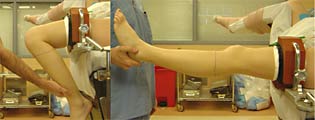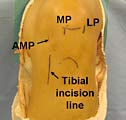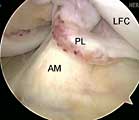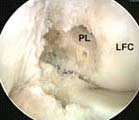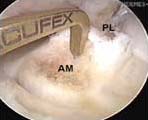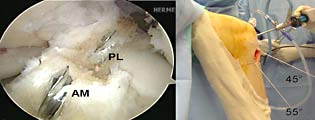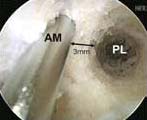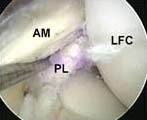Honing the anatomic double-bundle ACL reconstruction surgical technique
|
|
Editor’s note: Due to our readers’ response for more information about anatomic double-bundle ACL reconstruction, Freddie H. Fu, MD, of the University of Pittsburgh Medical Center and a member of the Orthopedics Today Editorial Board, provided a more complete overview of his surgical technique.
Anterior cruciate ligament reconstruction is the sixth most common procedure performed in orthopedics, with approximately 75,000 to 100,000 ACL reconstructive/repair procedures performed annually in the United States alone. The ACL has therefore been intensively studied, and outcomes of ACL surgery have been published in numerous articles.
Anatomic studies reveal the normal ACL to consist of two main bundles of ligament, termed the anteromedial (AM) and posterolateral (PL) bundles, based on their tibial insertion sites.
Traditional single-bundle ACL reconstruction has focused on reconstruction of one bundle of the ACL and outcomes have been reported with success rates between 69% and 95%. The question remains: Can there be improvement in functional outcomes as well as a reduction in the later development of degenerative arthritis in the reconstructed ACL knee?
A recent prospective study of a cohort of ACL-reconstructed patients seven years after surgery revealed degenerative radiographic changes in 95% of patients. The investigators also found that only 47% of patients were able to return to their previous activity level following ACL reconstruction.
Biomechanical studies have demonstrated that traditional ACL single-bundle reconstruction techniques are unable to restore normal kinematics, specifically the component of rotational kinematics. In contrast, studies have shown that an anatomic double-bundle reconstruction of both the AM and PL bundles is able to restore knee kinematics close to the normal state.
Functional outcomes have been studied in patients undergoing ACL reconstruction, and are better correlated with the presence or absence of a pivot shift than with anterior-posterior stability as measured by the Lachman exam and KT-1000. This suggests the importance of rotational stability in achieving favorable functional outcomes following ACL reconstruction.
We suggest that an ACL reconstruction using an anatomic double-bundle approach to restore both functional bundles of the ACL may result in improved patient outcomes. The following is a description of our present surgical technique.
|
|
|
|
|
|
|
|
Surgical technique
After identifying and marking the operative leg in the holding area, the patient is taken to the operating room and placed in a supine position on the operating table. The non-operative leg is wrapped and placed in a well-leg holder.
Following an examination under anesthesia, the operative knee is shaved and a pneumatic tourniquet is applied to the upper thigh. The leg is placed in a knee holder, and the foot of the operating table is fully retracted to allow for a range of motion between 0º and 120º [Fig. 1]. Correct intra-operative assessment of the knee flexion angle is essential to correct positioning of graft tunnels.
Next, the knee is prepped and draped in the standard fashion, and arthroscopic portals are established. The anterolateral portal is placed at the level of the inferior pole of the patella at the lateral border of the patella tendon. The anteromedial portal is placed just below the inferior pole of the patella approximately 1 cm lateral to the medial edge of the patella tendon. Finally, an accessory inferior medial portal is marked medial and distal to the inferomedial portal slightly above the meniscus, and is established later in the procedure [Fig. 2].
We initiate graft preparation on the back table during patient positioning and portal establishment. We prefer the use of two tibialis anterior or posterior tibialis allografts, which are typically between 24 cm and 30 cm in length. Each graft is folded over and trimmed to the appropriate diameter, typically 7 mm for PL, and 8 mm for AM. The ends of each graft are sutured using a “whip-stitch” with number 2 Ticron sutures. Prior to graft passage, an EndoButton CL (Smith and Nephew) is attached, with a loop length based on measurements of tunnel lengths.
Prior to assessment of the ACL, any meniscal or chondral pathology is addressed. Next, the rupture pattern of the AM and PL bundle is carefully evaluated using a thermal device [Fig. 3]. Special attention is given to the remaining fibers of each bundle, and the insertion sites of the AM and PL bundle are marked on both the femoral and tibial surfaces [Fig. 4]. The tibial footprints are partially preserved for their proprioceptive and vascular contributions.
Accessory medial portal
Next, the accessory medial portal is established using an 18-gauge spinal needle under direct visualization. This portal is essential to allow improved visualization of the lateral wall of the intercondylar notch and achieve correct placement of the PL femoral tunnel. We do not do any notchplasty.
With the scope in the medial portal, a 3/32 Steinman pin is introduced through the accessory medial portal, and is placed at the center of the PL femoral insertion site, approximately 5 mm posterior to the anterior articular cartilage border and 3 mm superior to the inferior border. Importantly, the knee is held in 90º flexion for this step, since the position of the femoral insertion sites changes with the knee flexion angle. With the knee in 0º, the PL femoral insertion is vertically oriented with the AM insertion. However, with the knee in 90º flexion, the insertion sites are oriented horizontally. Following verification of correct pin position, the knee is flexed to 110º, and the pin is malleted into place. A 7-mm acorn reamer is inserted over the guide wire with special attention taken to avoid injury to the articular surface of the medial femoral condyle. The PL tunnel is drilled to a depth of 25 mm, and depending on overall tunnel length, may later be hand-drilled to a final length of 30 mm [Fig. 5]. The far cortex is breached using a 4.5 mm EndoButton (Smith and Nephew) and total tunnel length is measured with a depth gauge.
Next, we turn our attention to the tibial tunnels. A 4-cm skin incision is made along the anteromedial tibia at the level of the tibial tubercle. An ACL tibial tunnel director guide (Arthrex) set at 55º is placed in the insertion site of the PL bundle, based on anatomic landmarks and previous marking [Figs. 6A-B].
The position of the director guide on the tibial cortex is just anterior to the superficial fibers of the medial collateral ligament.
Following PL guide pin placement, the guide is set to 45º, and is positioned in the AM tibial footprint [Fig. 7]. The starting point of the AM tunnel on the tibial cortex is more anterior, central, and proximal than the starting point of the PL tunnel.
The AM tibial guide pin is placed, and both pin positions are verified prior to tunnel drilling [Figs. 8A-B]. The tibial tunnels are overdrilled with 7 mm and 8 mm compaction drill reamers for the PL and AM tunnels, respectively.
|
|
|
|
|
|
Ensure correct placement
Finally, the AM femoral tunnel is established. Again, it is important to hold the knee in 90º flexion while determining pin position to ensure correct tunnel placement. The AM femoral tunnel guide pin is referenced approximately 3 mm posterior to the posterior rim of the PL tunnel, in a horizontal or slightly superior position [Fig. 9].
A transtibial approach is used in the majority of cases, but an accessory medial approach may be necessary to achieve correct position in some patients, to avoid a more vertical AM tunnel position.
Following verification of tunnel position, the knee is flexed to 110º, the guide pin is malleted into place, and an 8 mm acorn reamer is used to drill to a depth of 35 mm to 40 mm. A 4.5 mm EndoButton drill is used to breach the far cortex, and a depth gauge is used to measure tunnel length.
|
|
|
|
For PL graft passage, a Beath pin with a long loop suture attached is passed through the accessory medial portal, femoral PL tunnel and lateral thigh, with the knee hyperflexed to protect the peroneal nerve.
The suture is retrieved through the PL tibial tunnel using an arthroscopic suture grasper. The PL graft is passed and the EndoButton is flipped in the standard fashion to achieve femoral fixation.
The AM graft sutures are passed in a similar fashion. The crossing pattern of the two bundles of the ACL can be observed by taking the knee from flexion to extension. The AM graft is then passed and the EndoButton is flipped in the standard fashion for femoral fixation [Fig. 10].
The knee is cycled from 0º to 120º approximately 25 times for pre-conditioning of grafts. Each graft is fixed using a bioabsorbable interference screw and staple for secondary fixation. The PL graft is tensioned with the knee held in 0º, and the AM graft is tensioned with the knee in 60º flexion. Following fixation, the knee is tested for range of motion and stability, and the wounds are closed in the standard fashion. A Cryocuff (Aircast) is applied, and the leg is placed in a hinged knee brace locked in full extension.
Rehab program
Postoperative management follows our standard ACL protocol. The patient wears a leg brace for six weeks, and continuous passive motion stretching is initiated on the first postoperative day.
The patient uses crutches for four to six weeks, but patients are allowed to weight-bear as tolerated. We typically allow a return to full activities at six months.
Freddie H. Fu, MD, is chief of the department of orthopedics at the University of Pittsburgh Medical Center, and is a member of the Orthopedics Today Editorial Board.
For more information:
- ABOS. Diplomat 2004.
- Fithian DC, Paxton EW, Stone ML, et al. Prospective trial of a treatment algorithm for the management of the anterior cruciate ligament-injured knee. Am J Sports Med. 2005;33(3):335-346.
- Freedman KB, D’Amato MJ, Nedeff DD, et al. Arthroscopic anterior cruciate ligament reconstruction: a metaanalysis comparing patellar tendon and hamstring tendon autografts. Am J Sports Med.2003;31:2-11.
- Griffin LY, Agel J, Albohm MJ, et al. Non-contact anterior cruciate ligament injuries: risk factors and prevention strategies. J Am Acad Orthop Surg. 2000;8:141-150.
- Kocher MS, Steadman JR, Briggs KK, et al. Relationships between objective assessment of ligament stability and subjective assessment of symptoms and function after anterior cruciate ligament reconstruction. Am J Sports Med. 2004;32(3):629-634.
- Yagi M, Wong EK, Kanamori A, et al. Biomechanical analysis of an anatomic anterior cruciate ligament reconstruction. Am J Sports Med. 2002;30(5):660-666.
- Yamamoto Y, Hsu Y, Woo SL, et al. Knee stability and graft function after anterior cruciate ligament reconstruction: a comparison of a lateral and an anatomical femoral tunnel placement, Am J Sports Med. 2004;32(8):1825-1832.
- Yunes M, Richmond JC, Engels EA, et al. Patellar versus hamstring tendons in anterior cruciate ligament reconstruction: A meta-analysis. Arthroscopy. 2001;17:248-257.

![Freddie H. Fu, MD [photo]](/~/media/images/news/print/orthopedics-today/2006/04_april/fu_70_90_16428.jpg)
